Dynamic Pressure Test and Analysis of Marine Ballasted Centrifugal Pump under Rapid Changing Conditions
Abstract
:1. Introduction
2. Experiment System and Scheme Design
2.1. Research Object
2.2. The Experimental Design
2.3. The Experimental Scheme
2.4. Test Operating Steps
3. Results and Analysis
3.1. Time Domain Analysis of Pressure Fluctuation during the Rapid Reduction of Flow Rate
3.2. Dynamic Pressure Frequency Analysis
- (1)
- The frequency analysis of the dynamic pressure for P1
- (2)
- The frequency analysis of the rapid reduction in flow rate for P2
3.3. The Analysis of Inner Flow by Numerical Simulation Caiculation
4. Conclusions
- The dynamic pressure in the ballast pump periodically increases. The larger the amplitude of the flow reduction is, the greater the rate of the pressure increase. While the flow rate rapidly decreases to 0.4× Qd and 0.2× Qd, the pressure builds up quickly and then slowly.
- The dynamic pressure pulsation intensity of each transient scheme is higher than the corresponding steady-state conditions after the transient conditions. With the rapid reduction in the flow rate, the dominant frequencies of the dynamic pressure are 1APF and 1BPF and their harmonic frequencies.
- The rapid reduction in flow rate accelerates the separation of the vortex in the impeller channel, which shows that the separating vortexes are generated in advance, and their scale increases, which in turn reduces the pulsation intensity of the pump outlet and also causes an increase in the level of broadband pulsation between 2APF and 1BPF.
Author Contributions
Funding
Institutional Review Board Statement
Informed Consent Statement
Data Availability Statement
Conflicts of Interest
References
- Li, J.H. Design of simulation test platform for simi-submersible ship’s navigation ballast monitoring software. Ship Sci. Technol. 2020, 42, 191–193. [Google Scholar]
- Huang, C. Optimization Study on Ballast Pipe System for Large Barge Crane Vessel. Master’s Thesis, Shanghai Jiaotong University, Shanghai, China, 2012. [Google Scholar]
- Dazin, A.; Caignaert, G.; Bois, G. Transient behavior of turbomachinery: Applications to radial flow pump startups. J. Fluids Eng. 2007, 129, 1436–1444. [Google Scholar] [CrossRef]
- Xu, B.J.; Li, Z.F.; Wu, D.Z.; Wang, L.Q. Numerical simulation for transient turbulence flow of centrifugal pump during starting period. Sci. Online 2010, 5, 683–687. [Google Scholar]
- Wu, D.Z.; Xu, B.J.; Li, Z.F.; Wang, L.Q. Numerical simulation on internal flow of centrifugal pump during transient operation. J. Eng. Therm. 2009, 30, 781–783. [Google Scholar]
- Wu, D.Z.; Wang, L.Q.; Hu, Z.Y. Numerical simulation of centrifugal pump’s transient performance during rapid starting period. J. Zhejiang Univ. (Eng. Sci.) 2005, 39, 1427–1430. [Google Scholar]
- Li, W.; Zhang, Y.; Shi, W.D.; Ji, L.L.; Yang, Y.F.; Ping, Y.F. Numerical simulation of transient flow field in a mixed-flow pump during starting period. Int. J. Numer. Methods Heat Fluid Flow. 2018, 28, 927–942. [Google Scholar] [CrossRef]
- Farhadi, K.; Bousbia-salah, A.; D’Auria, F. A model for the analysis of pump start-up transients in Tehran Research Reactor. Prog. Nucl. Energy. 2007, 49, 499–510. [Google Scholar] [CrossRef]
- Jiang, Z.X.; Xie, J.L.; Gao, H. The Analysis of Transient Hydraulic Characteristics of Pump Startup-shutdown and Valve Closed in Closed Water System. Refri. Air Condi. 2015, 621–624. [Google Scholar]
- Rochuon, N.; Trébinjac, I.; Billonnet, G. An extraction of the dominant rotor-stator interaction modes by the use of proper orthogonal decomposition (POD). Int. J. Therm. Sci. 2006, 15, 109–114. [Google Scholar] [CrossRef]
- Tsukamoto, H.; Ohashi, H. Transient characteristics of a centrifugal pump during starting period. J. Fluids Eng. 1982, 104, 6–13. [Google Scholar] [CrossRef]
- Lefebvre, P.J.; Barker, W.P. Centrifugal pump performance during transient operation. J. Fluids Eng. 1995, 117, 123–128. [Google Scholar] [CrossRef]
- Thanapandi, P.; Prasad, R. A quasi-steady performance prediction model for dynamic characteristics of a volute pump. Proc. Inst. Mech. Eng., Part A 1994, 208, 47–58. [Google Scholar] [CrossRef]
- Wu, D.Z.; Jiao, L.; Wang, L.Q. Experimental study on transient performance of centrifugal pump under different starting acceleration. J. Eng. Thermophys. 2008, 29, 62–64. [Google Scholar]
- Zhang, S.S.; Wu, D.Z. Development of Transient Characteristic Test System of Centrifugal Pump. Acta Metr. Sini. 2005, 26, 159–162. [Google Scholar]
- Khalifa, A.E.; Alqutub, A.M.; Benmansour, R. Study of pressure fluctuations and induced vibration at blade-passing frequencies of a double volute pump. Arabian J. Sci. Eng. 2011, 36, 1333–1345. [Google Scholar] [CrossRef]
- Fu, S.; Zheng, Y.; Kan, K. Numerical simulation and experimental study of transient characteristics in an axial flow pump during start-up. Renew. Energy. 2020, 146, 879–1887. [Google Scholar] [CrossRef]
- Li, Z.F.; Wu, D.Z.; Wang, L.Q. Experiment on instantaneous characteristics in centrifugal pump during startup period. J. Drai. Irri. Mchi. Eng. 2010, 28, 389–393. [Google Scholar]
- Li, Z.F.; Wang, L.Q.; Dai, W.P. Diagnostics of a centrifugal pump during starting period based on vorticity dynamics. J. Eng. Thermphys. 2010, 31, 48–51. [Google Scholar]
- Wang, Y.; Chen, J.; Liu, H.L. Transient characteristic analysis of ultra-low specific-speed centrifugal pumps during startup period under shut-off condition. J. Agri. Eng. 2017, 33, 68–74. [Google Scholar]
- Shao, C. Research on Characteristic of Super-low Specific Speed Centrifugal Pumps during Transient Period. Master’s Thesis, Jiangsu University, Zhenjiang, China, 2016. [Google Scholar]
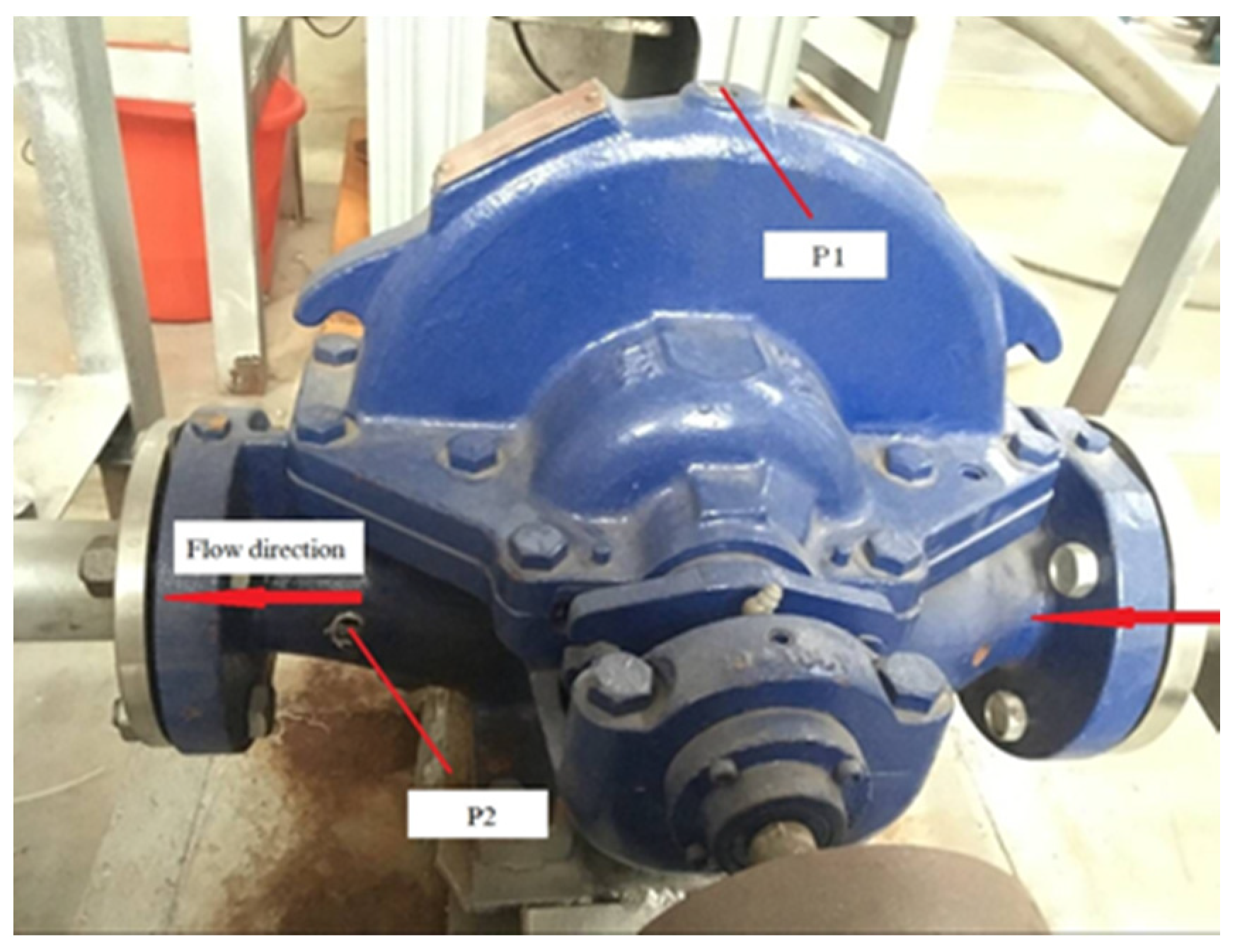
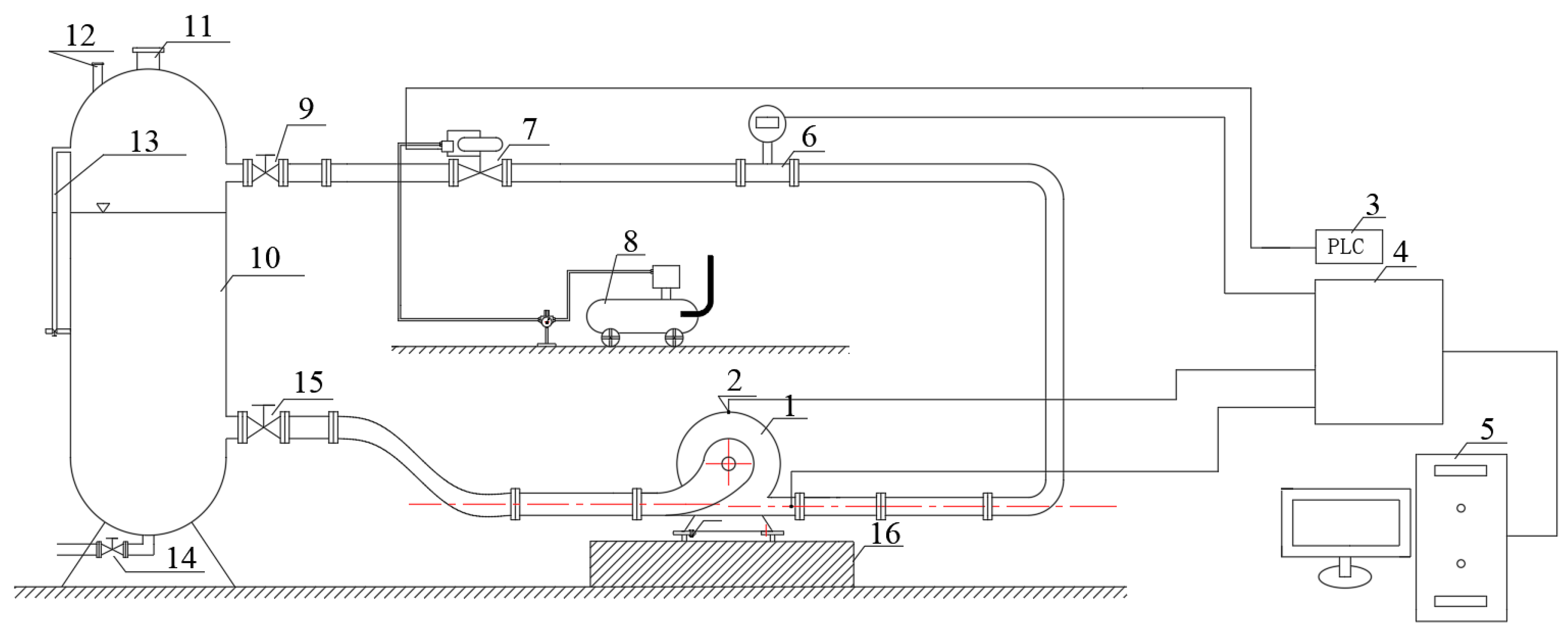
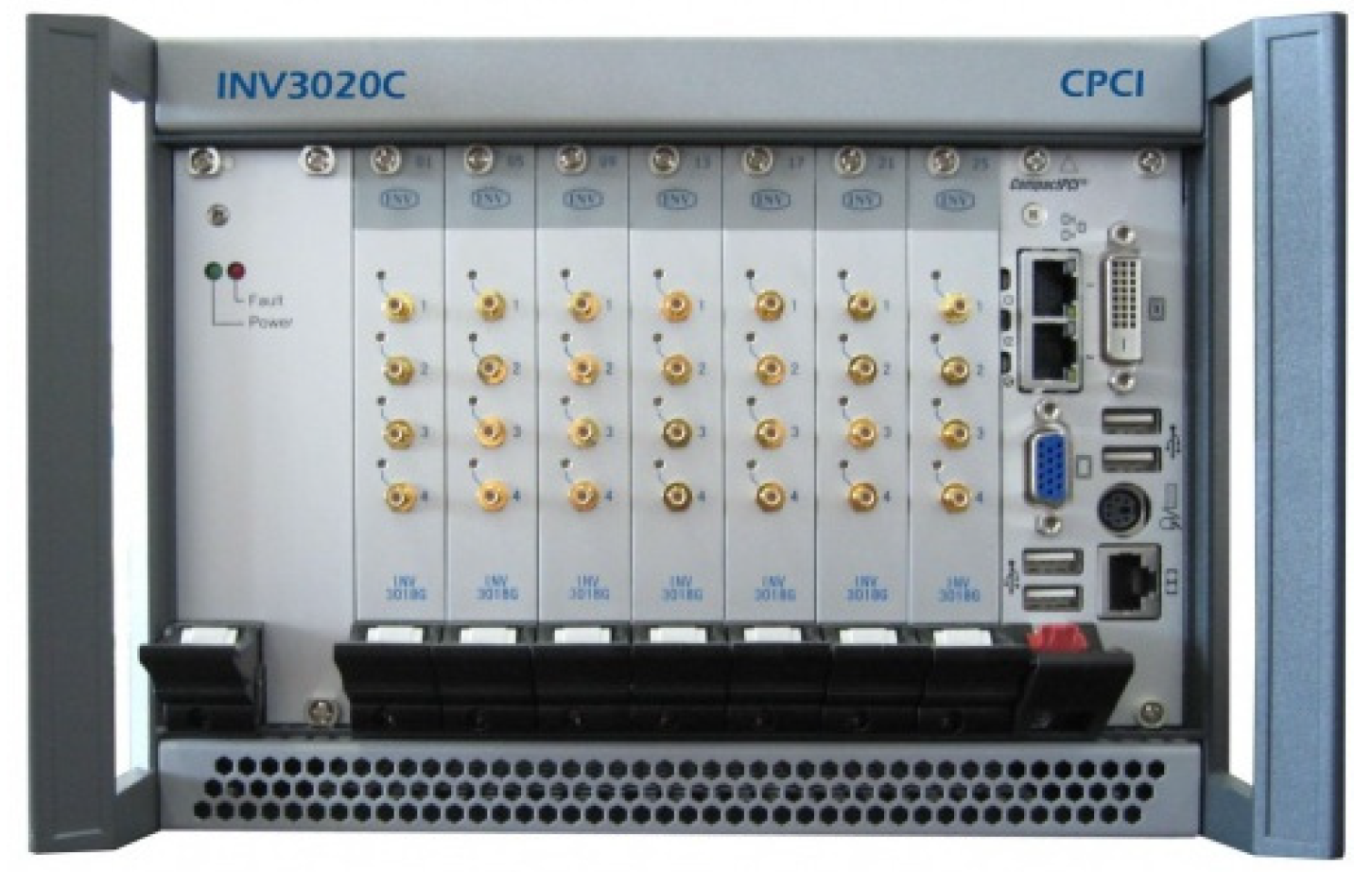
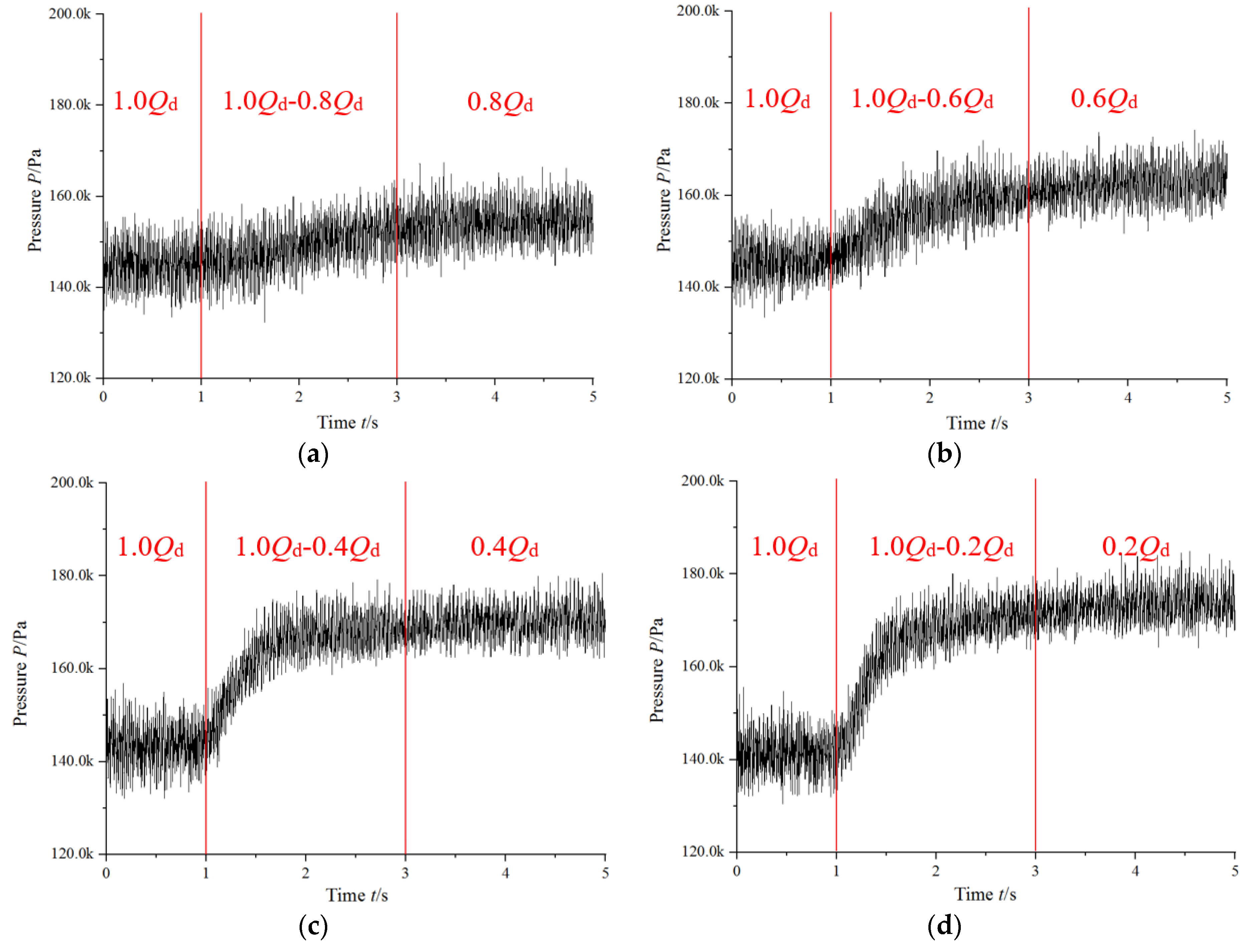
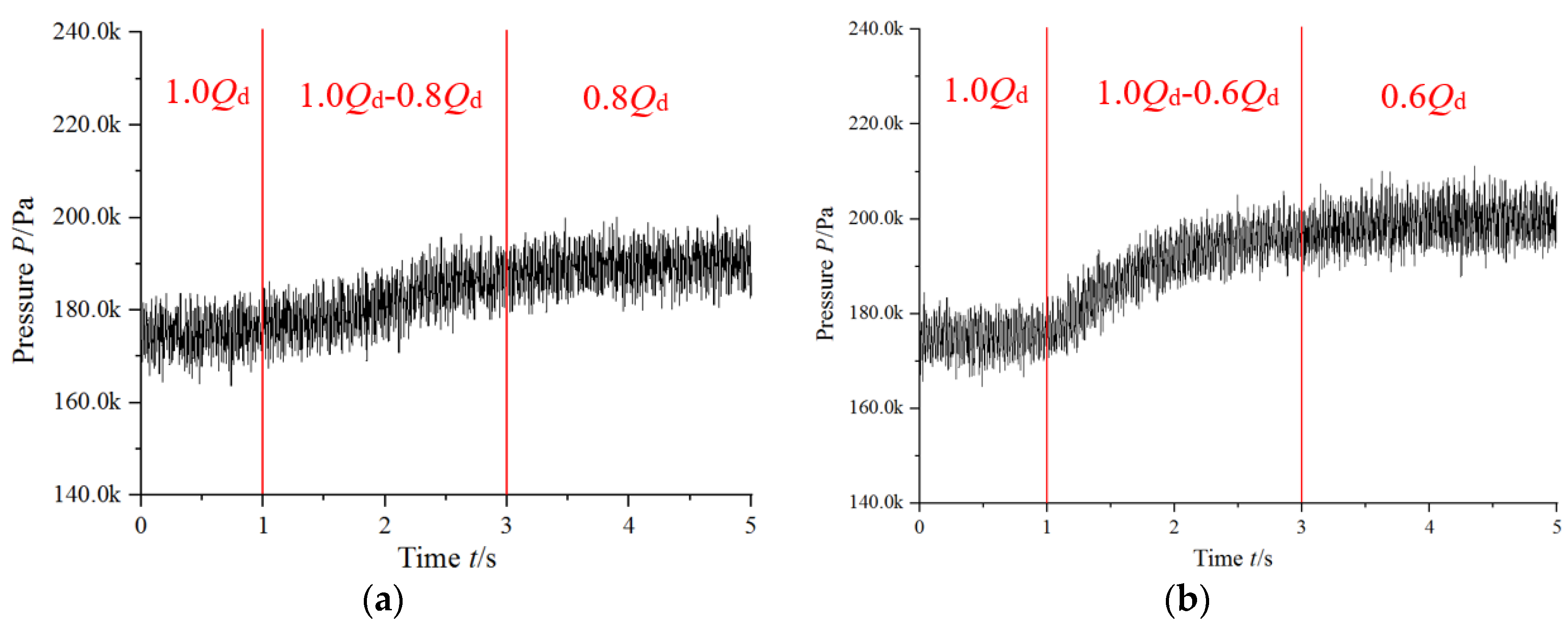
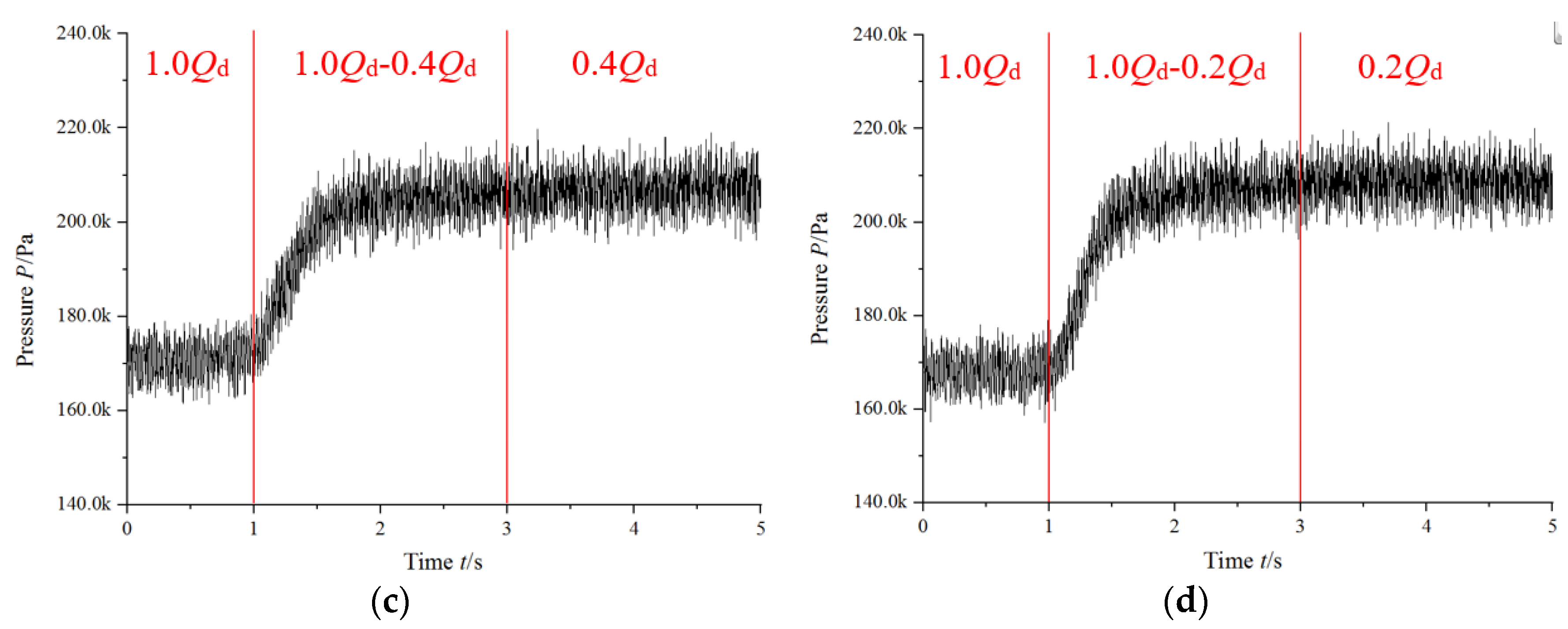
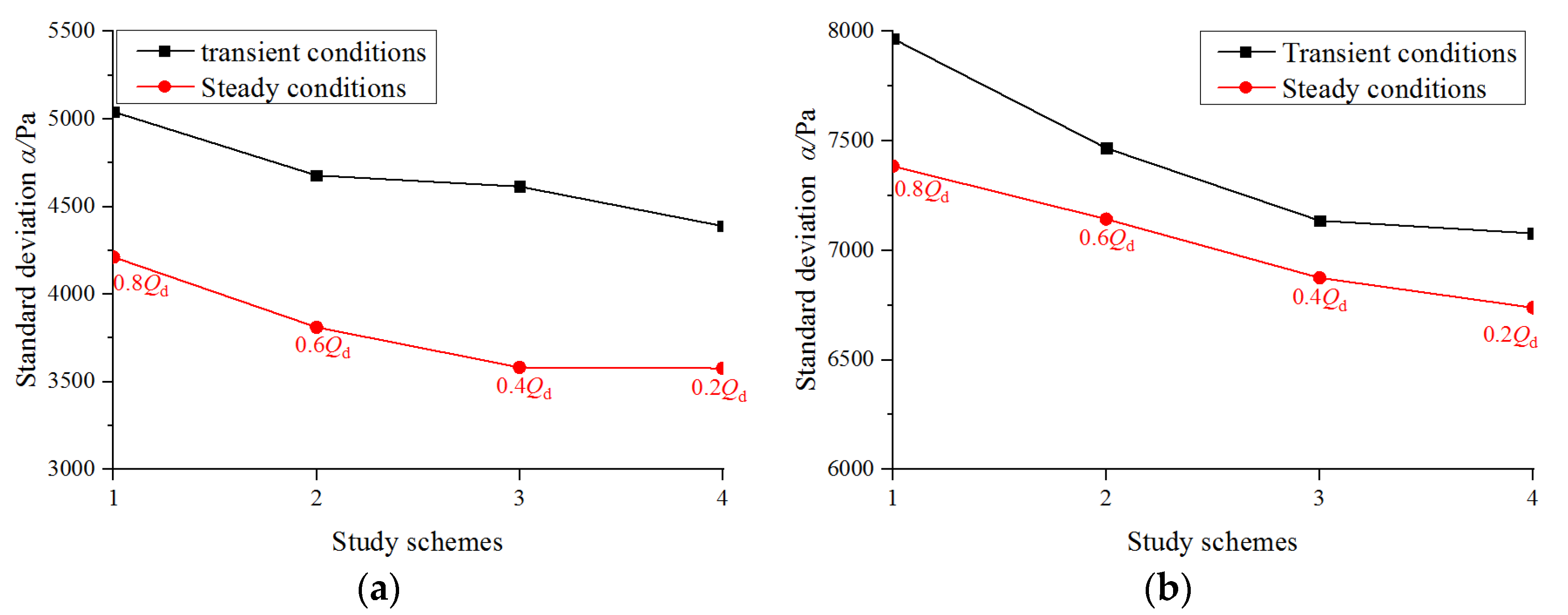
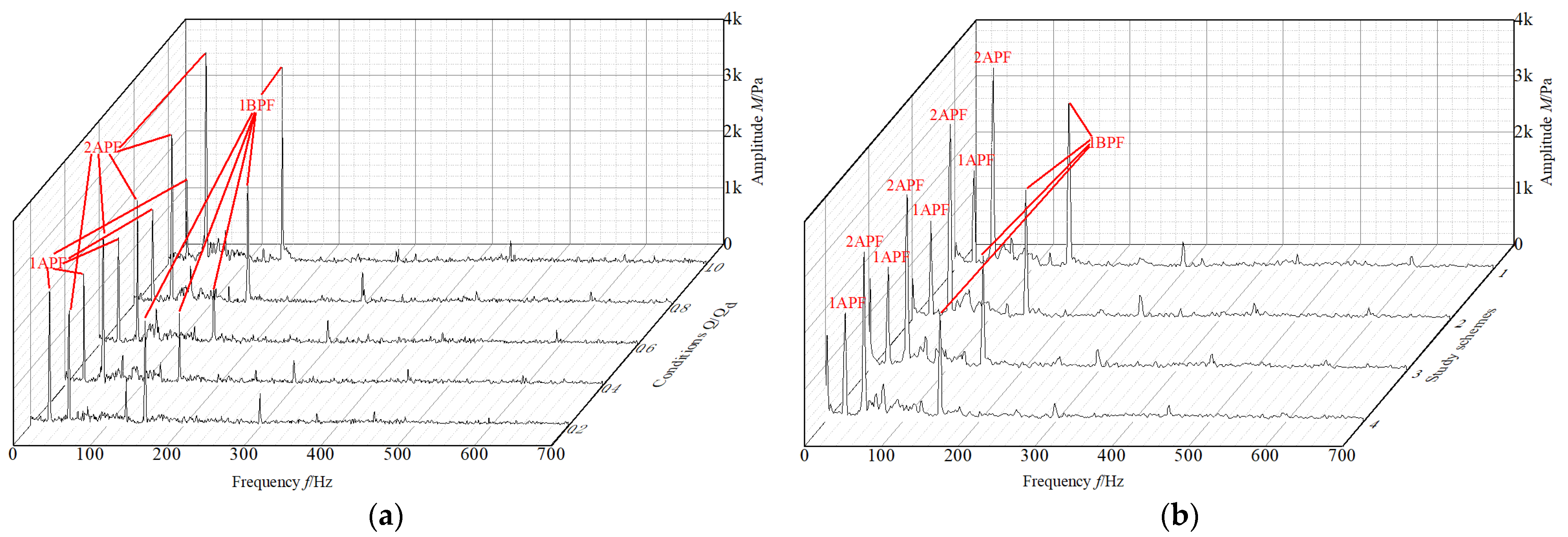

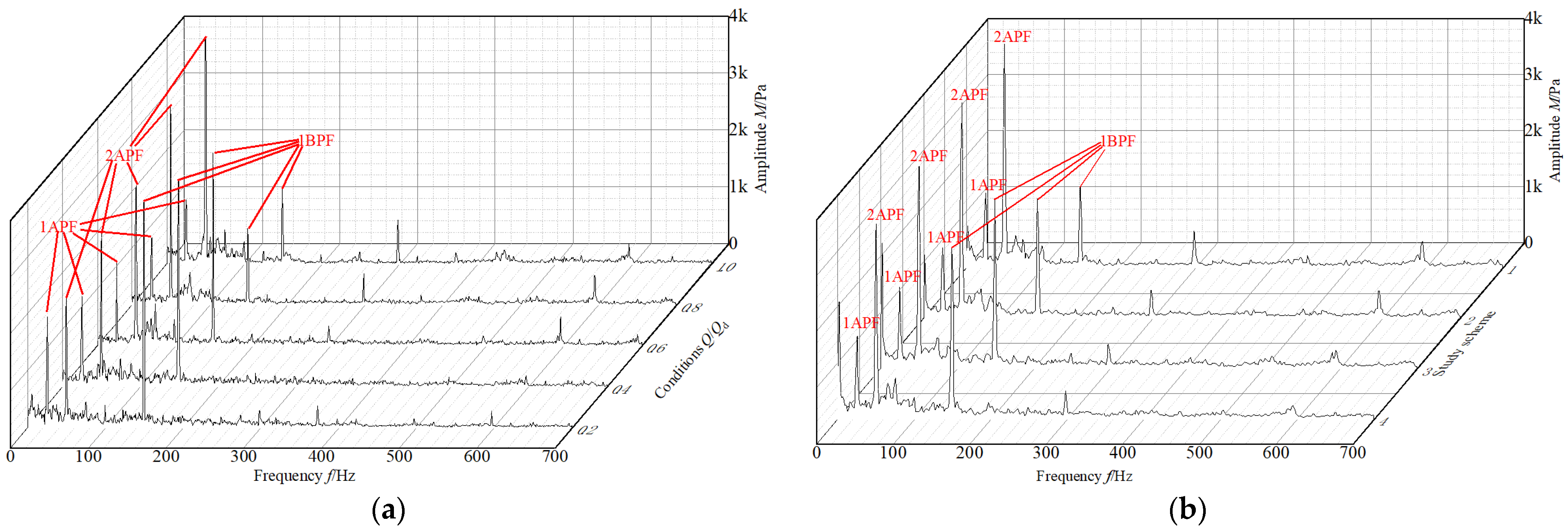



| Overflow Component | Geometric Parameters/Unit | Symbol | Value |
|---|---|---|---|
| Impeller | Inlet diameter/mm | D1 | 65 |
| Outlet diameter/mm | D2 | 214 | |
| Outlet width/mm | b1 | 8 | |
| Blade number | Z | 6 | |
| Volute | Diameter of basic circle/mm | D3 | 240 |
| Inlet width/mm | b2 | 20 | |
| Outlet diameter/mm | D4 | 50 |
| Parameters | Value |
|---|---|
| Measuring range | 0–1 MPa |
| Output signal | 4–20 mA |
| Precision grade | 0.25% Fs |
| Power supply | 10–28 VDC |
| Working condition | −10–80 °C |
| Experimental Schemes | |||
|---|---|---|---|
| S1 | S2 | S3 | S4 |
| 1.0× Qd–0.8× Qd | 1.0× Qd–0.6× Qd | 1.0× Qd–0.4× Qd | 1.0× Qd–0.2× Qd |
Publisher’s Note: MDPI stays neutral with regard to jurisdictional claims in published maps and institutional affiliations. |
© 2021 by the authors. Licensee MDPI, Basel, Switzerland. This article is an open access article distributed under the terms and conditions of the Creative Commons Attribution (CC BY) license (https://creativecommons.org/licenses/by/4.0/).
Share and Cite
Zhu, Z.; Liu, H. Dynamic Pressure Test and Analysis of Marine Ballasted Centrifugal Pump under Rapid Changing Conditions. J. Mar. Sci. Eng. 2021, 9, 1299. https://doi.org/10.3390/jmse9111299
Zhu Z, Liu H. Dynamic Pressure Test and Analysis of Marine Ballasted Centrifugal Pump under Rapid Changing Conditions. Journal of Marine Science and Engineering. 2021; 9(11):1299. https://doi.org/10.3390/jmse9111299
Chicago/Turabian StyleZhu, Zhipeng, and Houlin Liu. 2021. "Dynamic Pressure Test and Analysis of Marine Ballasted Centrifugal Pump under Rapid Changing Conditions" Journal of Marine Science and Engineering 9, no. 11: 1299. https://doi.org/10.3390/jmse9111299
APA StyleZhu, Z., & Liu, H. (2021). Dynamic Pressure Test and Analysis of Marine Ballasted Centrifugal Pump under Rapid Changing Conditions. Journal of Marine Science and Engineering, 9(11), 1299. https://doi.org/10.3390/jmse9111299





